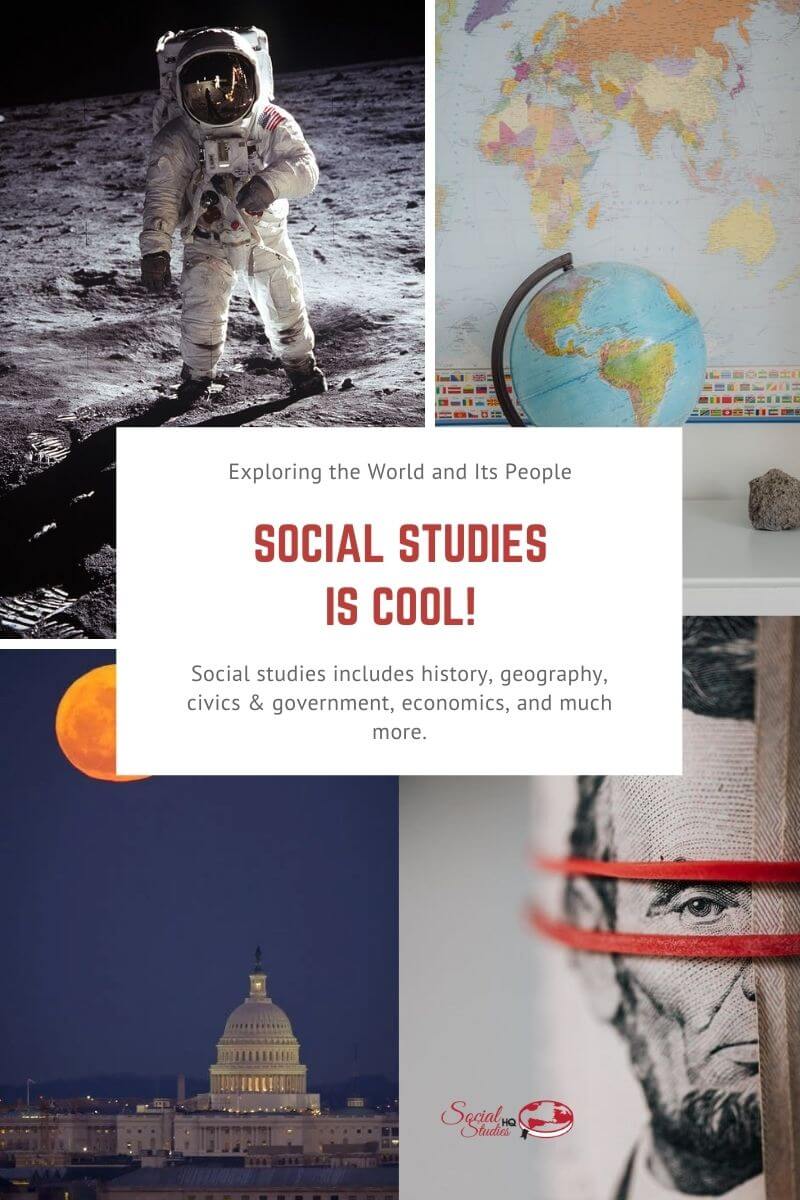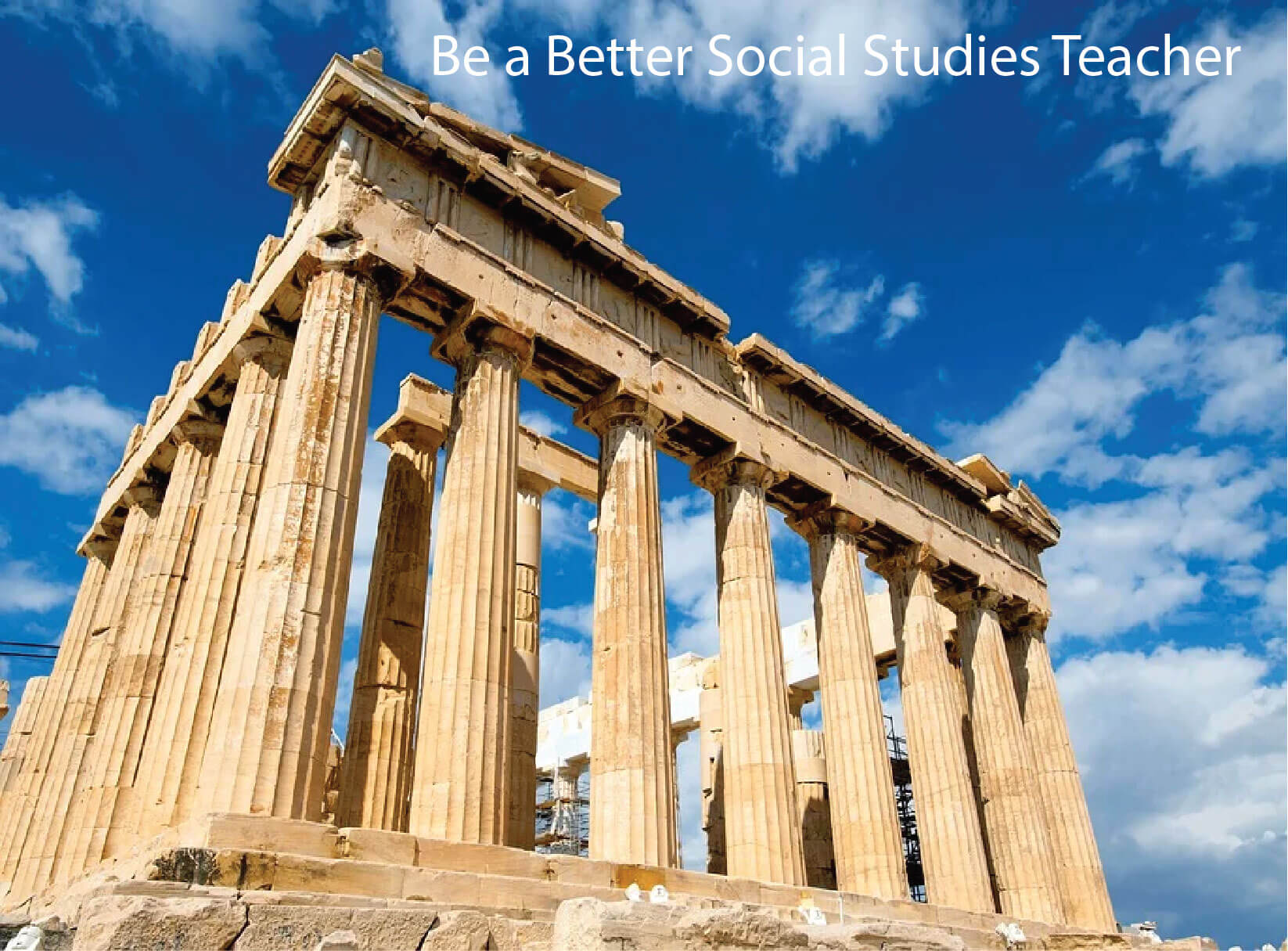Need more resources for your social studies classroom?
If so, you are in the right place!
Social studies can be one of the most interesting subjects in the school curriculum because at its root it is about people. But it is also one of the most demanding subjects to teach, in my opinion.
Effective social studies teaching requires a command of content as well as a thorough knowledge of instructional strategies.
While those things are challenging in and of themselves, working conditions are frequently a challenge as well. How many preparations per day are you responsible for? At times, I’ve had to teach as many as four different subjects per day. I have known teachers who have been responsible for as many as five!
It seems like social studies teachers often have extra duties as well. Student council, coaching, and other responsibilities also add to our challenges.
If you are an elementary teacher, you can also relate, I’m sure, to being responsible for teaching multiple subjects per day while managing a classroom full of children. Then there are all of the meetings and other duties, like lunch duty, differentiation, and helping children with special needs.
If any of this sounds familiar to you, we can help!

Social studies instruction is a vital part of a student’s education.
According to the National Council for the Social Studies, “the primary purpose of social studies is to help young people make informed and reasoned decisions for the public good as citizens of a culturally diverse, democratic society in an interdependent world.”
I don’t know about you, but I feel that is a major responsibility. I am always wondering and worrying if I am doing enough, and doing the right things, to help my students be good citizens who dare to stand for what they believe in and also respect the rights of others.
In my high school-level social studies classes, I use a variety of methods to provide my students with the learning they need. For children to acquire important knowledge and skills, they must be engaged in the lesson. I teach by engaging students with visuals and texts. My students find this especially helpful as many social studies lessons can be a bit dry. I often start my lesson with a short reading to get the students thinking about what it is we are about to learn.
Teaching social studies is a wonderful way to bring history and geography alive. Social studies combine both subjects into one cohesive learning experience that not only educates the students but also provides them with tools they will need for their future.
Since social studies is an integrated subject, we can not only teach history and geography together but we can also bring in the economics, government, and humanities content as well. This makes social studies challenging to teach but also interesting at the same time.
So, what exactly is social studies?
Often, you will hear social studies referred to as a combination of 5 subjects: history, geography, economics, government, and civics.
History involves the study of past events. Geography is about studying places on Earth; it also involves examining the relationship between people and their environment. Economics includes how societies use resources to support human activities; this might involve trade or barter for goods and services. Government focuses on how people work together to make decisions and laws, create governments, and settle disputes among people. Civics is the study of rights, freedoms, responsibilities, and ethics within a government.
Social studies instruction can also include teaching about culture and society. For example, students can learn about the music and art of a particular time period.
Social studies is a wonderfully engaging subject that can be applied to almost everything. Students need to learn about their world today as well as the past. Social studies is the perfect way to do this!
What is the main goal of social studies?
The main goal of social studies is to help students become good citizens who are critical thinkers. Social studies provides a unique learning opportunity for students as it teaches them how to identify issues, solve problems, make decisions, and communicate their opinions. We need to give children the skills they need now more than ever before!
What goals do you have for your social studies students?
Of course, social studies does not just have one goal. It can have what seems like an infinitely large selection of goals. I always have more goals and ideas than I can ever accomplish.
Social studies can help students to:
- Improve their reading and writing skills
- Learn to analyze information and situations
- Develop critical thinking skills
- Understand democratic values at a deeper level
- Learn the skills and knowledge to be an active and engaged citizen
- Develop cultural awareness and understanding
- Know how the economy works
- Understand history and how it impacts the present
How can we teach social studies?
Social studies can be taught with traditional techniques such as lectures, textbooks, writing assignments, and tests. However, social studies lends itself to a variety of more creative strategies such as project-based learning, inquiry-based learning, and gamification. Gamification of learning involves using games or game-like elements in an educational setting. Games are enjoyable, motivating, and encourage participation. They can motivate students to work hard and be willing to make mistakes rather than fear failure.
7 Innovative Teaching Strategies to Make Social Studies Come Alive
The teaching methods you use are essential to fostering a love for learning, which is what social studies should be all about.
1. Sharing real-life stories in class
For instance, when learning about the history of immigration in the US, share true stories from modern immigrants who have come into your community. Doing this will bring history to life for your students and may even inspire some of them to share their own family's immigration stories.
2. Make connections to today
Tying subjects in education back to things they are familiar with will help you reach them on an intellectual level. For example, when studying about the Great Depression, have students write letters to their mothers or fathers describing what is going on in the world today.
3. Use realia
Real objects, practical demonstrations, and visual materials have a powerful effect on memory retention. Thousands of years ago, Roman orators would use various types of items to help them remember their speeches as they spoke. Today, educators can still benefit from using visual aids as a teaching strategy because students respond to them instinctively.
4. Encourage participation from students
A common mistake that teachers make when covering social studies is thinking that the lesson will succeed automatically without any effort on their part or their students' parts, but that's simply not true. For example, have your class conduct a mock election to learn all about the electoral process.
5. Use games and puzzles
Using engaging activities with your students makes learning fun, which can help you achieve greater results in the long run. An example of a game that is easy to set up is having kids roll dice to answer social studies questions or play Jeopardy! with questions about history.
6. Teach through real-life videos
Using films, documentaries or even amateur YouTube clips may help you connect with your students. For example, if you're teaching about the Vietnam War, show films of refugees fleeing their homes and speak with some of them after class to learn how they ended up in America.
7. Teach them through songs
Reaching students through the medium of music is a time-tested method because everyone loves to sing. For example, if you're learning about the American Revolution, have your class learn about Paul Revere's ride by singing "One if by Land" or other songs from that time period.
Why teach social studies?
Studying social studies provides an opportunity for students to learn how the world works, help them understand other people's views/perspectives, and improve their critical thinking skills.
Social studies education is more than simply memorizing facts about our country's history, it's also about helping students understand why things happen the way they do and preparing them to be active citizens in a democratic society.
What are the 7 themes of social studies?
Social studies is an important subject both nationally and internationally because it teaches students about the world around them and how people of different cultures live.
There are many ways to divide and group social studies content. For example, we could say that some important topics in social studies are geography, history, economics, religion, anthropology, political science, law, art history, sociology, and psychology.
Then we could divide these topics into seven themes: geographical concepts, historical events, cultural development, people in power and politics, living conditions (such as poverty), and globalization. The theme of geography includes location, climate, and human-environment interaction; the theme of history includes major turning points in civilization; the theme of culture includes traditions, arts, and lifestyles; the theme of power and politics includes how people have been ruled in the past and at present, their rights and freedoms; the theme of human condition includes poverty, malnutrition, and disease; the theme of globalization includes issues such as identity, belongingness, and economic development.
So, let’s get started!
Although social studies can seem like an intimidating subject, it's also a great way to help students learn about the world around them. We supply resources and ideas to make social studies the powerful, rewarding, enjoyable, and meaningful subject that it is meant to be. Check out my What is Social Studies page to learn more about this fascinating subject or use the menu bar at the top of the page to see what else we have to offer.



New! Comments
Have your say about what you just read! Leave me a comment in the box below.